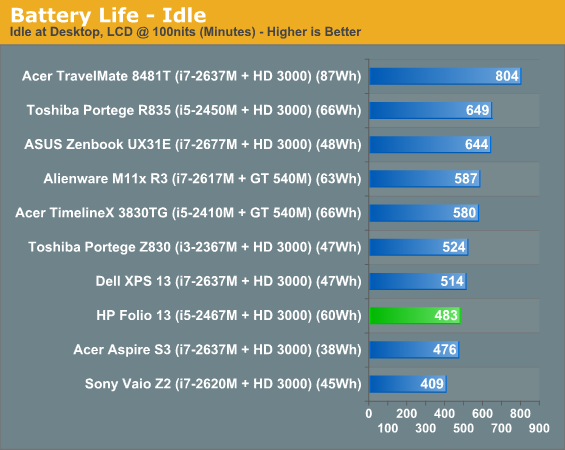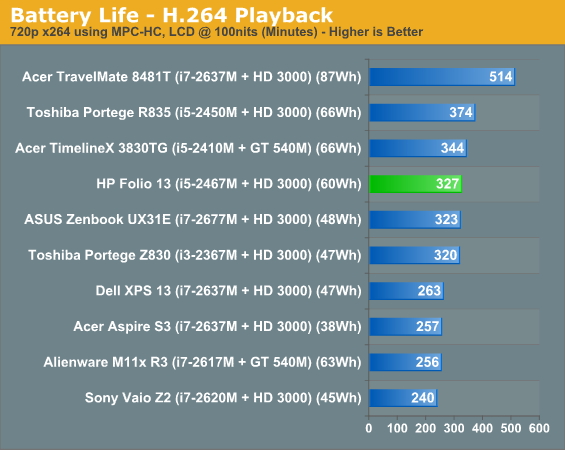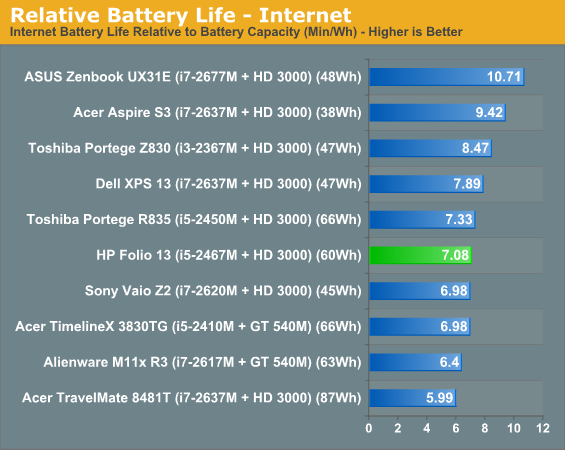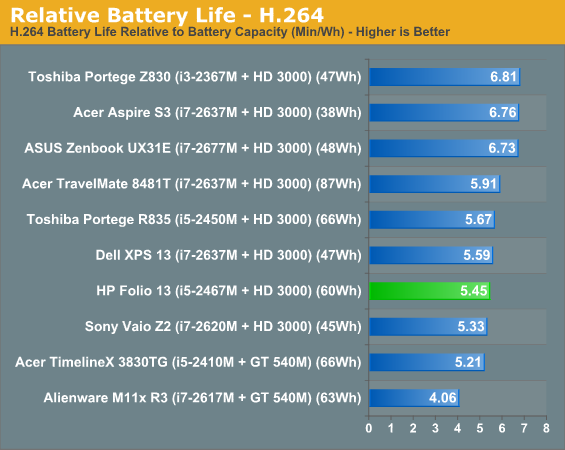HP Folio 13 Review: Deviating From the Norm
by Dustin Sklavos on April 17, 2012 12:30 AM EST- Posted in
- Laptops
- Intel
- HP
- Sandy Bridge
- Ultrabook
Battery Life
HP's engineers seem to have short-changed some of the hardware itself in the Folio 13, but those sacrifices (along with sacrifices in form factor) were made in an effort to cram as large a battery as possible into the Folio 13. Indeed, it does include the biggest internal battery of any of the ultrabooks we've tested; the Acer TravelMate's battery is bigger on paper but it sticks out of the chassis slightly, while the Alienware M11x R3 can't really be classified as an ultrabook.






Interestingly, despite having a bigger battery than much of the competition, HP's Folio 13 is only able to provide middling efficiency. Battery life isn't poor by any stretch of the imagination, but ultimately the gamble doesn't seem to have paid off as much as HP would've liked as it's clear there's still some optimization that needs to be done.
Heat and Noise
Another area where the HP Folio 13 benefits tremendously as the result of HP's engineers willing to go a little bit thicker than the competition is in its cooling system. Noise even under load is a fairly quiet whine, and the system does a good job of keeping the i5 running frosty.

Having gotten used to seeing systems running in the 80s and higher, it's refreshing to see the Folio 13 only peaking in the mid-70s where full-sized notebooks tend to hang out. That said, I'm still not thrilled with the idea of having the fan intake on the bottom of the ultrabook (or on any laptop, really). As systems designed to be as light and portable as possible it stands to reason these are going to be used on laps most of the time, and while HP smartly positions the intake near the back and center of the bottom of the notebook, it still seems like this could cause problems. I feel like there has to be a better way to turn ultrabooks into true laptops.










88 Comments
View All Comments
JarredWalton - Wednesday, April 18, 2012 - link
We'll have a full update to this when we test Ivy Bridge and Trinity -- HD 3000 "gaming" is really a stretch regardless, so hopefully IVB does better. Will it be as power efficient as Llano/Trinity? I have no idea, but it could be -- 22nm Tri-gate transistors might be just what Intel needs (along with better graphics drivers).french toast - Wednesday, April 18, 2012 - link
Thanks Jarred, be great to see which chips are better in actual notebook scenarios, that tests the capabilities of the chip, especially graphics.Intel have been very poor, but they have improved immensely in the last 2 years, drivers are the real problem..i also hear 22nm is a very 'hot' process..and not in a good way..
seapeople - Tuesday, April 17, 2012 - link
Chips generally perform worse on battery because the operating system is set to reduce performance to save battery life. Once you override this you can get full performance, though if you're playing something like a game that runs at 100% then be prepared to get 1/3rd the battery life.french toast - Wednesday, April 18, 2012 - link
Yes, but some chips perform better off battery than otherss, and seeing as you have likely bought a laptop to be carrying around (as oppose to a comparitivly cheaper tower to plug in) then a more realistic way to measure performance is off the battery..this could be in the same chart as the mains test, i have linked an example above.jbh129 - Tuesday, April 17, 2012 - link
Please include a MacBook Air in these comparisons. It is still the premier ultra book and the standard by which others can be judged.Mitch89 - Tuesday, April 17, 2012 - link
Especially since, in my experience, the Air runs Windows 7 very well, should you want to.My dad has had both the previous gen and now the top-spec i7 Air running exclusively on Windows 7, and he loves it.
From the sounds of it, these "Ultrabooks" are anything but.
DigitalFreak - Tuesday, April 17, 2012 - link
Whomever decided to design this with a single memory channel should be taken out back and shot. It's inexcusable, especially with integrated graphics.Gunbuster - Tuesday, April 17, 2012 - link
saw 768p, clicked back to home page.rscoot - Tuesday, April 17, 2012 - link
Yeah, pretty much. My 7 year old powerbook G4 had a better screen than 99% of notebooks being released today and its totally inexplicable.seapeople - Tuesday, April 17, 2012 - link
I like the step function that differentiates panel contrast ratio between vendors; if it's Sony or Apple, then contrast is ~800, otherwise contrast is ~200.Makes things simple.